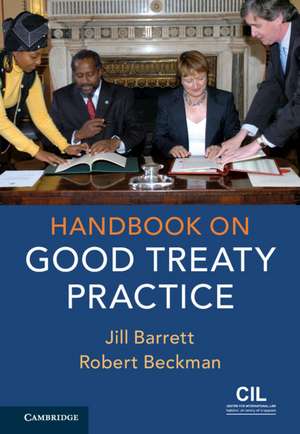Handbook on Good Treaty Practice
Autor Jill Barrett, Robert Beckmanen Limba Engleză Paperback – 11 mar 2020
| Toate formatele și edițiile | Preț | Express |
|---|---|---|
| Paperback (1) | 405.54 lei 3-5 săpt. | |
| Cambridge University Press – 11 mar 2020 | 405.54 lei 3-5 săpt. | |
| Hardback (1) | 918.65 lei 39-44 zile | |
| Cambridge University Press – 11 mar 2020 | 918.65 lei 39-44 zile |
Preț: 405.54 lei
Nou
77.60€ • 82.98$ • 64.70£
Carte disponibilă
Livrare economică 27 martie-10 aprilie
Specificații
ISBN-10: 1107530687
Pagini: 530
Ilustrații: 3 b/w illus. 17 tables
Dimensiuni: 171 x 243 x 29 mm
Greutate: 0.86 kg
Editura: Cambridge University Press
Colecția Cambridge University Press
Locul publicării:New York, United States
Cuprins
Recenzii
'This Handbook will be of great practical importance. It does not just assemble rules, practices and clauses in order to illustrate the life of international treaties. It delivers much more: it is a Manual on good treaty practice, designed to educate those in the front line of treaty work on how to handle everything they might come across in their job not only in a correct, but in an optimal way. The scope and depth of the Handbook are truly impressive without being intimidating; the language is clear and the many examples are well-chosen. The work lives up to the – Plato – standard it itself sets for treaty practice: professional, legal, assured, transparent, organised.' Bruno Simma, Former Member of the International Law Commission and of the International Court of Justice, Judge at the Iran-United States Claims Tribunal (The Hague)
'This remarkable book provides a unique and insightful account of all aspects of treaty practice and as such will not only be essential reading for government officials whose work relates to treaties, but will also be of considerable interest to international law practitioners and academics.' Dan Sarooshi, Essex Court Chambers and University of Oxford
'Treaty law is a very important component of international law. Diplomats, government legal advisers and legal practitioners are frequently engaged in the process of making, interpreting and implementing treaties. They will find this Handbook an indispensable guide to good treaty practice.' Tommy Koh, Ambassador-at-Large, Ministry of Foreign Affairs, Singapore
Descriere
This Handbook aims to provide practical guidance on good treaty practice. It presents a range of examples from the practice of several States and international organisations and explains the actions that need to be taken to create a new treaty, bring it into force, operate it, amend it and wind it up, on both the international and the domestic plane. It also explores what constitutes good treaty practice, and develops generic principles or criteria against which to evaluate these examples. It provides a useful analytical tool to enable each government and international organisation to identify and develop the best treaty practice for their circumstances, recognising that one size does not necessarily fit all. It will be of interest to those working with treaties and treaty procedures in governments, international organisations and legal practice, as well as legal academics and students wishing to gain insight into the realities of treaty practice.
